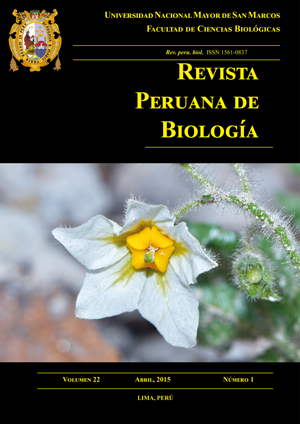New mammalian records in the Parque Nacional Cerros de Amotape, northwestern Peru
DOI:
https://doi.org/10.15381/rpb.v22i1.11124Keywords:
Pacific Tropical Rainforest, Equatorial Dry Forest, mammals, camera trapping, transect census.Abstract
The Pacific Tropical Rainforest and Equatorial Dry Forest are found only in southern Ecuador and northern Peru, and are among the most poorly known ecosystems of South America. Even though these forests are protected in Parque Nacional Cerros de Amotape (PNCA), they are threatened by fragmentation because of farming and agriculture. The aim of this study was to determine the medium and large mammalian species richness, using transect census, camera trapping, and specimen bone collection. Nine transects were established and 21 camera trap stations were placed along 16 km2 in three localities of PNCA, from August 2012 to April 2013. Total sampling effort was 215 km of transects and 4077 camera-days. We documented 22 species; including 17 with camera trapping, 11 with transect census, and 10 with specimen collection. Camera traps were the most effective method, and four species (Dasyprocta punctata, Cuniculus paca, Leopardus wiedii and Puma concolor) were documented only with this method. This comprised the first Peruvian record for Dasyprocta punctata, and the first record for the western slope of the Peruvian Andes for Cuniculus paca. Also, both specimen collections and sightings confirm the presence of Potos flavus, first record in the western slope of the Peruvian Andes. Panthera onca, Tremarctos ornatus and Saimiri sciureus are considered locally extinct, while several species are in need of further research. We highlight the importance of the high diversity of this rainforests and encourage local authorities to give the area the highest priority in conservation.Downloads
Downloads
Published
Issue
Section
License
Copyright (c) 2015 Cindy M. Hurtado, Víctor Pacheco

This work is licensed under a Creative Commons Attribution-NonCommercial-ShareAlike 4.0 International License.
AUTHORS RETAIN THEIR RIGHTS:
a. Authors retain their trade mark rights and patent, and also on any process or procedure described in the article.
b. Authors retain their right to share, copy, distribute, perform and publicly communicate their article (eg, to place their article in an institutional repository or publish it in a book), with an acknowledgment of its initial publication in the Revista Peruana de Biologia.
c. Authors retain theirs right to make a subsequent publication of their work, to use the article or any part thereof (eg a compilation of his papers, lecture notes, thesis, or a book), always indicating its initial publication in the Revista Peruana de Biologia (the originator of the work, journal, volume, number and date).


















